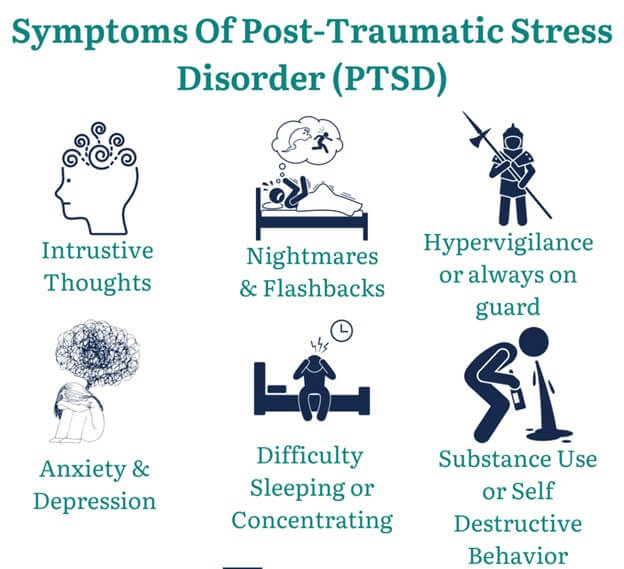A nurse is caring for a client who was involved in heavy combat and observed war casualties. The nurse should suspect that the client is suffering from posttraumatic stress disorder (PTSD) if the client makes which of the following statements?
"My child was born with a birth defect due to an exposure I had overseas."
I check any room I enter because the enemy is still after me and could be hiding anywhere."
"In my dreams, all I can see are the wounded reaching out and trying to grab me."
"I killed four enemy soldiers with my bare hands and saved my entire battalion."
The Correct Answer is C
A) "My child was born with a birth defect due to an exposure I had overseas."
This statement does not directly relate to the core symptoms of PTSD. While exposure to trauma can have a variety of consequences, including potential exposure-related health issues, this statement does not necessarily indicate the re-experiencing, avoidance, or hyperarousal symptoms characteristic of PTSD.
B) "I check any room I enter because the enemy is still after me and could be hiding anywhere."
This statement is more indicative of hyperarousal and hypervigilance, which are common symptoms of PTSD. However, it does not explicitly involve re-experiencing the traumatic event through nightmares or intrusive memories, as described in the correct answer.
C) "In my dreams, all I can see are the wounded reaching out and trying to grab me."
Explanation:
The statement "In my dreams, all I can see are the wounded reaching out and trying to grab me" indicates symptoms commonly associated with posttraumatic stress disorder (PTSD). This statement reflects the re-experiencing symptom cluster of PTSD, where individuals may have distressing and intrusive memories, nightmares, or flashbacks related to the traumatic event they experienced. The imagery of wounded individuals trying to grab the person suggests a strong emotional impact and ongoing distress related to the traumatic experience.
D) "I killed four enemy soldiers with my bare hands and saved my entire battalion."
While this statement might reflect exposure to a traumatic event and could contribute to symptoms of PTSD, it is presented in a way that seems more like a narrative of heroic actions rather than a symptom of distress or re-experiencing.

Nursing Test Bank
Naxlex Comprehensive Predictor Exams
Related Questions
Correct Answer is A
Explanation
Lithium is a commonly used medication for treating bipolar disorder, and therapeutic drug monitoring is crucial to ensure its effectiveness and prevent potential toxicity. Monitoring the client's lithium levels in the blood is important because lithium has a narrow therapeutic range, meaning that levels that are too low might not provide the desired therapeutic effect, while levels that are too high can lead to toxicity.
B) "This medication is addictive, so you will need to discontinue it in six months."
Lithium is not considered addictive. It's important to provide accurate information about the nature of the medication to avoid unnecessary concerns.
C) "Weight gain should be reported to your provider as an indication of lithium toxicity."
While weight gain can be a side effect of some medications, it's not a specific indicator of lithium toxicity. Lithium toxicity is characterized by a range of symptoms including tremors, confusion, nausea, vomiting, and excessive thirst, among others.
D) "Your provider may prescribe a diuretic if you have trouble urinating while taking lithium."
Diuretics are generally not recommended with lithium because they can increase the risk of lithium toxicity. Lithium can affect kidney function, and using diuretics may exacerbate this effect. The client should be advised not to use diuretics without consulting their healthcare provider.
Correct Answer is B
No explanation
Whether you are a student looking to ace your exams or a practicing nurse seeking to enhance your expertise , our nursing education contents will empower you with the confidence and competence to make a difference in the lives of patients and become a respected leader in the healthcare field.
Visit Naxlex, invest in your future and unlock endless possibilities with our unparalleled nursing education contents today
Report Wrong Answer on the Current Question
Do you disagree with the answer? If yes, what is your expected answer? Explain.
Kindly be descriptive with the issue you are facing.
